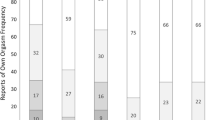Abstract
In a previous article, we presented phallometric data to illustrate a case of preferential bestiality or zoophilia (Earls & Lalumière, Sex Abuse: J Res Treat, 14:83–88, 2002). Based on the available literature, we argued that a marked preference for having sex with animals over sex with humans is extremely rare. In the present article, we describe a second case of zoophilia that challenges the widely held assumptions that men who have sex with animals are generally of below average intelligence and come from rural areas. In addition, we provide a brief review of a burgeoning quantitative literature using large groups of zoophiles recruited from internet sources. Although estimates of the prevalence of zoophilia are not possible at this time, it appears that zoophilia is not as rare as once thought and shares many features with other atypical sexual interests.
Similar content being viewed by others
Notes
Some authors have also used the phrase “zoosexual orientation” to denote a sexual preference for animals (e.g., Beetz, 2004). In the present article, we make a distinction between the behavior of having sex with an animal (bestiality) and a clear preference for engaging in sex with animals (zoophilia or preferential bestiality).
References
Beetz, A. M. (2004). Bestiality/zoophilia: A scarcely investigated phenomenon between crime, paraphilia, and love. Journal of Forensic Psychology Practice, 4, 1–36.
Blanchard, R. (1989). The concept of autogynephilia and the typology of male gender dysphoria. Journal of Nervous and Mental Disease, 177, 616–623.
Duffield, G., Hassiotis, A., & Vizard, E. (1998). Zoophilia in young sexual abusers. Journal of Forensic Psychiatry, 9, 294–304.
Earls, C. M., & Lalumière, M. L. (2002). A case study of preferential bestiality (zoophilia). Sexual Abuse: A Journal of Research and Treatment, 14, 83–88.
Freund, K., & Blanchard, R. (1993). Erotic target location errors in male gender dysphorics, paedophiles, and fetishists. British Journal of Psychiatry, 162, 558–563.
Gates, K. (2000). Deviant desired: Incredibly strange sex. New York: Juno Books.
Gebhard, P. H., Gagnon, J. H., Pomeroy, W. B., & Christenson, C. V. (1965). Sex offenders: An analysis of types. New York: Harper Row.
Hensley, C., Tallichet, S. E., & Singer, S. D. (2006). Exploring the possible link between childhood and adolescent bestiality and interpersonal violence. Journal of Interpersonal Violence, 21, 910–923.
Kazdin, A. E. (1998). Research design in clinical psychology (3rd ed.). Toronto: Allyn & Bacon.
Kinsey, A. C., Pomeroy, W. B., & Martin, C. E. (1948). Sexual behavior in the human male. Philadelphia: W. B. Saunders.
Lawrence, A. A. (2006). Clinical and theoretical parallels between desire for limb amputation and gender identity disorder. Archives of Sexual Behavior, 25, 263–278.
McNally, R. J., & Lukach, B. M. (1991). Behavioral treatment of zoophilic exhibitionism. Journal of Behavioral Research and Experimental Psychiatry, 22, 281–284.
Miletski, H. (2000). Bestiality/zoophilia: An exploratory study. Scandinavian Journal of Sexology, 3, 149–150.
Miletski, H. (2005). Is zoophilia a sexual orientation? A study. In A. M. Beetz & A. L. Podberscek (Eds.), Bestiality and zoophilia: Sexual relations with animals (pp. 82–97). Ashland, IN: Purdue University Press.
Seto, M. C. (2008). Understanding pedophilia and sexual offending against children: Theory, assessment, and intervention. Washington, DC: American Psychological Association.
von Krafft-Ebbing, R. (1950). Psychopathia sexualis (12th ed.). New York: Pioneer Publications.
Williams, C. J., & Weinberg, M. S. (2003). Zoophilia in men: A study of sexual interests in animals. Archives of Sexual Behavior, 32, 523–535.
Acknowledgments
The authors would like to thank David Brousseau, James Cantor, Meredith Chivers, Vern Quinsey, Michael Seto, Annabree Simpson, Kelly Suschinsky, and Paul Vasey for providing useful feedback on an earlier version of this article. Paul Vasey also brought to our attention the phenomenon of furvets. This work was supported in part by a Social Sciences and Humanities Research Council Standard Research Grant awarded to M.L.L.
Author information
Authors and Affiliations
Corresponding author
Rights and permissions
About this article
Cite this article
Earls, C.M., Lalumière, M.L. A Case Study of Preferential Bestiality. Arch Sex Behav 38, 605–609 (2009). https://doi.org/10.1007/s10508-007-9285-x
Received:
Revised:
Accepted:
Published:
Issue Date:
DOI: https://doi.org/10.1007/s10508-007-9285-x




